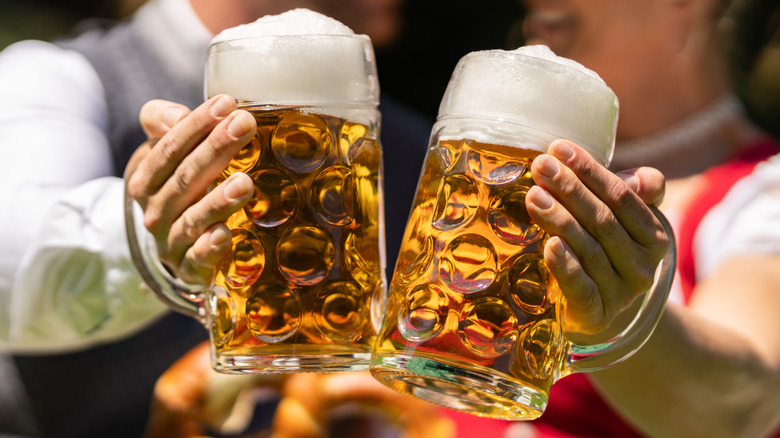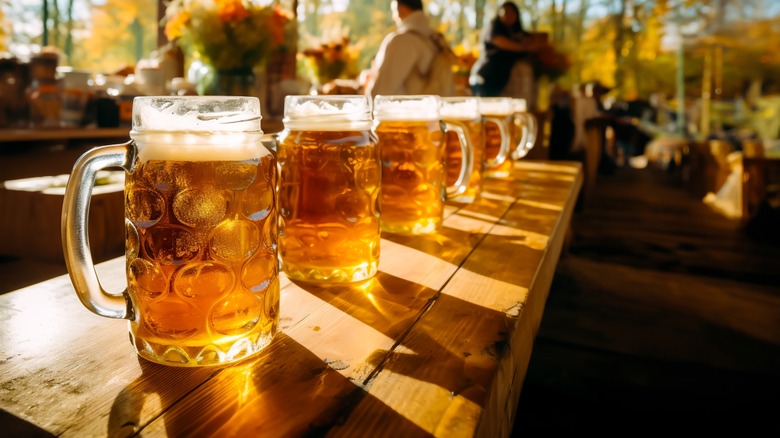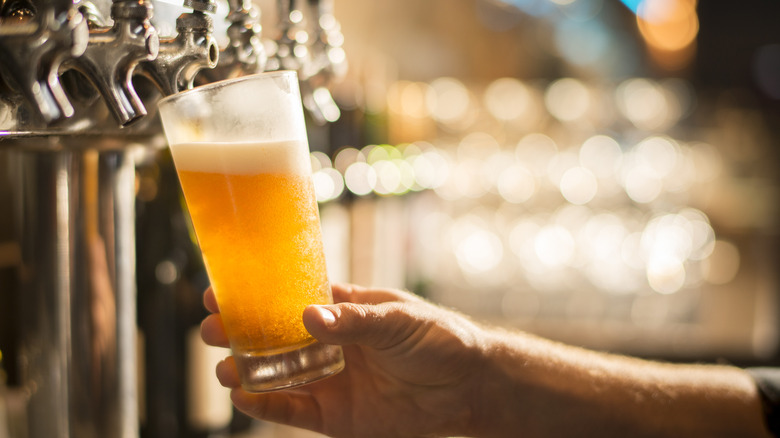German Vs American Beer: Know The Differences For Oktoberfest
While Oktoberfest was originally developed to honor the nuptials of German royalty, these days, the celebration is mostly focused on boozy revelry. But when Oktoberfest is in full swing, you may start pondering the differences between German beers and their American counterparts. One major difference between the two countries' brews is the use of ingredients.
The German beer purity law (also known as the Reinheitsgebot) was enacted in 1516 to deter the inclusion of subpar ingredients. As such, German brewers were only permitted to use water, yeast, malt, and hops when making beer. The law was officially repealed in 1987, but many German brewers and drinkers still hold it in high esteem.
As for American beer production, brewers don't necessarily feel beholden to guidelines. In fact, American craft beers can get downright (ahem) crafty when it comes to ingredients. Craft beers can contain unexpected additions like candy, clams, and even scrapple, which consists of pork scraps. However, experimentation is much less of a thing with tried-and-true American domestics, such as Bud Light, which sticks to a sparse ingredient list of water, rice, barley, and hops.
German beer: a style for every mood
There are quite a few German beer styles out there, and these vary according to flavor, alcohol by volume (ABV), and color. Pilsners, a type of lager, are quite common in the country, and this style actually inspired American versions like Bud and Miller. With German pilsners, you can expect a light, slightly bitter beer with an ABV ranging between 4.4% and 5.2%.
If you're seeking something a bit more robust, a German bock is the way to go. Bocks feature a malty flavor that's tempered by the hops' bitterness. Bocks are also darker in color than pilsners and often have an ABV ranging between 6.3% and 7.5% for a more potent beverage.
There's also Schwarzbier, a dark-hued lager that features a roasted malt flavor with just a twinge of sweetness. Despite their robust flavor and appearance, Schwarzbiers have a reasonable ABV that ranges from 5% to 6%. And if you prefer your beer to be more like a meal, Rauchbier is said to have a smoky, almost meaty flavor, though this can be a bit polarizing among palates. This flavorful German beer features an ABV between 4.8% and 6%, and it has a rich brown color that may be lighter or darker depending on the brewing process.
America's craft beer revolution
American domestic beers include selections like Bud and Miller Light, as well as Yuengling, Rolling Rock, and Coors. While popular, these selections are often criticized for being somewhat one-note and flavorless, which may explain why the craft beer movement had such a massive impact on beer lovers in the U.S. While it's believed that home brewers in the 1970s ignited the craft beer craze, the movement didn't pick up steam until the '90s, which is when microbreweries began cropping up around the nation.
In the simplest terms, craft breweries have a small production scale of 6 million barrels or fewer per year, and they're mostly independently owned, meaning that any established beer company with a stake in the craft brewery must own less than 25% of the business. The definition of craft beer is a bit harder to parse, but it's generally accepted that craft brews are more likely to experiment with surprising ingredients and, as a result, offer a wider selection of flavors, unlike the expected flavor of popular American domestic beers.
Overall, the primary difference between German and American beer seems to be the preference for traditional recipes, as opposed to the drive for innovation. Both countries have a lot to offer Oktoberfest revelers, and that's definitely a good thing.


